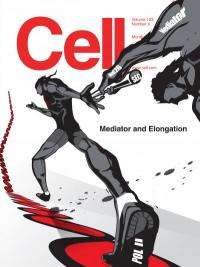Control of gene expression: Mediator MED26 shifts an idling polymerase into high gear

Look up "transcription"—the copying of a gene's DNA into RNA intermediaries—in any old molecular biology text book, and it all seems very simple: RNA polymerase II, the enzyme that catalyzes the reaction, assembles at the start site and starts motoring down the strand, cranking out the RNA ribbon used to construct proteins. But researchers now know that RNA polymerase II often stalls on DNA strands where it was once assumed to just barrel down.
A report from the Conaway lab at the Stowers Institute for Medical Research in the July 8, 2011, edition of the journal Cell identifies a switch that allows RNA polymerase to shift gears from neutral into drive and start transcribing. This work sheds light on a process fundamental to all plant or animal cells and suggests how transcriptional anomalies could give rise to tumors.
"Transcription is at the heart of everything that happens in an organism," says Joan Conaway, Ph.D., Investigator and the study's senior author. "If you want to understand what is going right and what is going wrong in a cell, it is important to understand its mechanism."
Previously, researchers knew that almost all transcription required interaction of a 30-protein complex, collectively termed Mediator, with RNA polymerase, or pol II. "Mediator containing a subunit called MED26 bound tightly to pol II worked better to stimulate transcription," says Conaway. "What we have now shown is that MED26 also interacts with factors promoting RNA elongation—which makes it even more interesting."
"There are frequent roadblocks in transcriptional elongation," said Laurie Tompkins, Ph.D., who oversees transcriptional mechanisms grants at the NIH, including one that supported this work. "The discovery that MED26 plays a crucial role in overcoming one clarifies how an essential cellular process is regulated and suggests new strategies for regulating gene expression in healthy and diseased cells."
The all-Stowers team led by first author Hidehisa Takahashi, Ph.D., a post-doctoral fellow in the Conaway lab, utilized biochemistry and a mass spectrometry method called Multidimensional Protein Identification Technology, or MudPIT, to show that MED26 acts as a go-between linking transcriptional complexes carrying out seemingly disparate jobs, namely the assembly of pol II on the DNA track versus setting it in motion.
"Through MudPIT, we found that a complex containing elongation factors binds to a MED26 region called the N-terminal domain," says Takahashi. "Biochemical assays showed that those same regions were required for Mediator to recruit elongation factors to DNA."
The team then showed that Med26 was required for expression of genes at which pol II was known to pause, suggesting that Med26 recruited elongation factors to jump-start the stalled polymerase at that juncture. One elongation factor shown to interact biochemically with MED26 was ELL, purified in the 90's by co-author and Stowers Investigator Ali Shilatifard, Ph.D., when he was a postdoctoral fellow in the Conaway lab at the Oklahoma Medical Research Foundation.
This work suggests that before RNA elongation, MED26 as a component of Mediator sits huddled with resting pol II, sequestering it near the start gate. Biochemists alliteratively call this behavior "pol II promoter-proximal pausing" or as Joan Conaway puts it, "It just looks like pol II can't get out of the DNA driveway and into the street." And although the polymerase occasionally lurches forward attempting to commence elongation, full-bore elongation occurs only when MED26 lets go of start-site factors and grabs onto elongation factors like ELL, releasing pol II to transcribe RNA.
Richard Young, Ph.D., a member of the Whitehead Institute and professor of Biology at MIT, says the new study makes a seminal contribution to the transcription field. "This extremely important work connects regulation of transcriptional initiation with that of elongation," says Young, one of the first to identify Mediator subunits in yeast in the early 80's. "This is critical because developmental anomalies and key human diseases share deficiencies at this nexus."
Factors governing RNA elongation have historically been overlooked, as researchers focused on how pol II is assembled. "Now we know that polymerases initiate and produce short RNA transcripts in cells from yeast to humans but additional stimulus of elongation is required to fully transcribe genes," says Young. "This means that elongation control is much more important than previously appreciated."
An interesting corollary is that some leukemias are caused by gene translocations that create hybrids of elongation proteins like ELL and other factors —so the new connection to Mediator reported by the Conaway lab suggests that inappropriate gene expression in tumor cells could result in part from mistargeting mediator and pol II to the wrong chromosomal locations.
Why would Mother Nature would devise ornate schemes just to copy DNA into RNA? Co-author Ron Conaway, Ph.D., Investigator and co-PI of the lab, speculates that they allow fine-tuning of gene expression and as a bonus provide medicinal chemists with numerous drug targets.
Regarding the former, Joan Conaway explains that assembling multiple pol II components on a gene about to be expressed is difficult to synchronize. "If you want a gene to be a fast responder you must have everybody ready at the start line," she says. "Then all you have to do is release the polymerase."
Provided by Stowers Institute for Medical Research

















